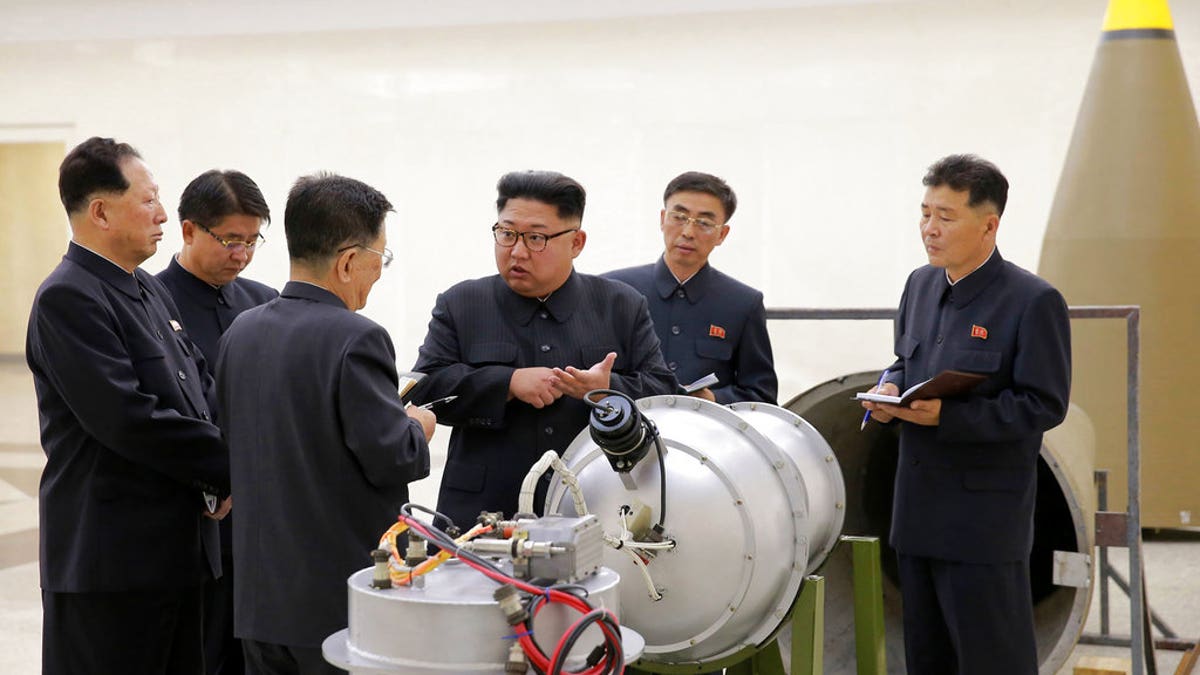
If North Korea fires a missile at the U.S., there may not be much time to react, officials tell Fox News. (Korean Central News Agency/Korea News Service via AP)
Defense Secretary Jim Mattis said recently it would be "game on" if North Korea were to fire a missile at the United States or its allies, but how fast things would happen is not so clear.
A leading expert in missile defense told Fox News there would not be much time to decide to shoot down a North Korean missile.
“This is a game of minutes, but the initial detection of a launch would be really in terms of seconds,” said Thomas Karako, senior fellow and director of the Missile Defense Project at the Center for Strategic and International Studies.
“Keep in mind the entire flight time from North Korea to the United States is well under any hour [and] the authority is given in advance. It's predesignated,” he added.
There are reports that President Trump has already authorized his national security team to act if a North Korean missile is headed toward Guam, Hawaii or the U.S. homeland.

When any missile is launched around the world, it produces a plume and heat signature that is quickly picked up by U.S. military spy satellites. Almost immediately the information is transferred to the North American Aerospace Defense Command, better known as NORAD, as well as the U.S. Strategic Command, which controls the military’s nuclear forces.
Karako says both NORAD and U.S. Strategic Command quickly assess where the missile is going and decide whether it is a threat to the United States, its allies or any U.S. military forces in the region.
U.S. missile defense has come a long way since its inception 13 years ago. By the end of this year, 44 ground-based interceptor missiles will be housed in silos between two U.S. Air Force bases in Alaska and California.
The last two tests of the ground based interceptors have been successful despite a spotty track record previously.
“I'm very confident…that this system can and will defend the homeland if attacked,” said the former head of the U.S. Missile Defense Agency, Vice Adm. James D. Syring.
But even this new technology needs improving. Today’s “kill vehicle” from the interceptor missiles dates back to the 1990s, according to Karako.
To protect South Korea and the U.S. territory of Guam, the U.S. military has deployed the THAAD anti-ballistic missile system.
Right now THAAD (Terminal High Altitude Area Defense) is only operated by the United States military, but there are only a few systems available to deploy.
“The United States has only about five or six [THAAD] batteries for the world,” said Karako.
The United Arab Emirates has two THAAD batteries and the Saudis have announced they will be purchasing seven batteries, Karako said.
THAAD is a perfect 15 for 15 over its lifetime in controlled tests to destroy short or medium range ballistic missiles, including two recent tests from Kodiak, Alaska which shot down ballistic missiles over the Pacific.
THAAD missiles intercept ballistic missiles when they re-enter the Earth’s atmosphere.
But Karako says the THAAD battery currently deployed to South Korea is only “finite.”
THAAD will not protect the 25 million people living in and around Seoul, but it will buy the military time to strike back, according to Karako.
“North Korea has hundreds of missiles, the THAAD battery is not there to defend the entire peninsula,” said Karako. “This is not about having a perfect shield and sitting there and playing catch.”
This week, the U.S. Army added four more launchers - over the objections of Russia and China - to join the two already in place bringing the total now to 48 missiles to defend South Korea.
Japan does not have the THAAD system.
Sitting off shore are Aegis destroyers that are designed to shoot down ballistic missiles outside the atmosphere in space.
Protecting Japan are Patriot missile batteries to provide a last ditch protection should any missiles get through the Aegis warships deployed at sea.
The aircraft carrier USS Ronald Reagan was put to sea this morning from Tokyo Bay for preplanned training exercises at sea, according to the U.S. Navy.
Separately, a ballistic missile defense warship will always be on alert near Japan. Defense Secretary Jim Mattis will join the president and the rest of the cabinet along with their families at Camp David this weekend.
And on Friday, a US Navy official confirmed that four warships had joined the USS Ronald Reagan at sea for a "routine patrol," just a month after the aircraft carrier's month-long maintenance period in Japan. The official says that two of the four warships are ballistic missile defense ships capable of shooting down North Korean missiles.
The four warships carry more than 100 Tomahawk cruise missiles among them.
Ahead of a meeting with Kuwaiti Deputy Prime Minister and Defense Minister Sheikh Mohammed Al-Khaled Al-Hamad Al-Sabah at the Pentagon Thursday, Defense Secretary Mattis was asked by a reporter what would happen if North Korea fired a missile at the United States or threatened any allies this weekend.
"We'll deal with it," he replied.

